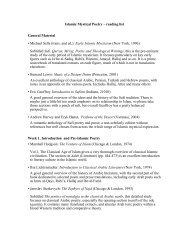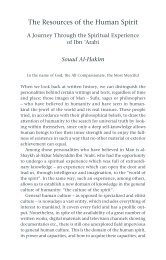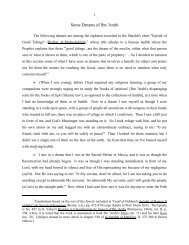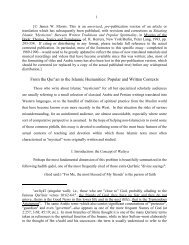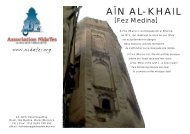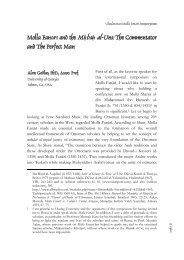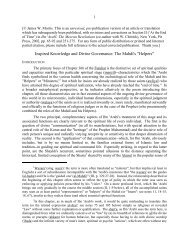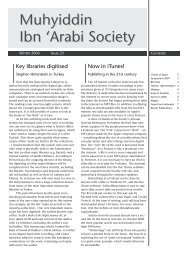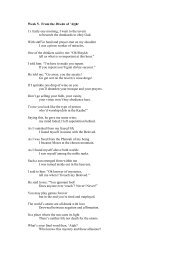Part III (pdf) - Muhyiddin Ibn Arabi Society
Part III (pdf) - Muhyiddin Ibn Arabi Society
Part III (pdf) - Muhyiddin Ibn Arabi Society
You also want an ePaper? Increase the reach of your titles
YUMPU automatically turns print PDFs into web optimized ePapers that Google loves.
15when set against the relatively greater theological and philosophic emphasis of most earlier (andlater) writers in this school, no doubt helped account for the wide diffusion and acceptance of hiswritings among Sufis from Muslim India (where Jîlî traveled) to the Ottoman lands. 93 However,that same richness and depth of implicit references (again comparable to the later Neoplatonists),which pose such a dilemma for students in most domains of later Islamic culture, are aformidable obstacle for modern students and translators—a fact which may explain the limitedavailability of his writings in any Western language.Titus Burckhardt’s partial translation of the opening, metaphysical chapters of Jîlî’s K.al-Insân al-Kâmil [De l'Homme Universel. Pp. 101. Paris: Dervy-Livres. 1975 (1st ed. 1953). /English transl. (from the French) by A. Culme-Seymour. Universal Man. Pp. 93. Sherborne,UK: Beshara Publications. 1983.], with its extensive introduction and careful treatment ofphilosophic vocabulary (including an excellent glossary), has been a classic introduction to thisdimension of <strong>Ibn</strong> ‘Arabî’s thought for many years. However, the translator’s intentionallylimited selection of topics and particular pedagogical intention—both carefully acknowledged inthe opening sections 94 —necessarily lead the uninitiated reader in a direction almost the opposite(at least historically speaking) of that actually followed by the author. For it is very difficult,unless the reader is already quite familiar with <strong>Ibn</strong> ‘Arabî and his earlier commentators, to seehow Jîlî is actually using their familiar concepts and terminology in an independent, creative93 For Jîlî’s travels and life, see the article by Helmut Ritter, “‘Abd al-Karîm al-Djîlî” inEI 2 , vol. I, p. 71; the importance of the Yemen in Jîlî’s life reminds us of the still virtuallyunknown story of the acceptance and development of <strong>Ibn</strong> ‘Arabî’s influence among Sufis there(a subject evoked only briefly at the end of A. Ateº’s article on <strong>Ibn</strong> ‘Arabî in the EI 2 ). Some ideaof the spread of Jîlî’s ideas and writings, especially in subsequent Turkish Sufism, can begathered from the locations of manuscripts of his works listed in Brockelman, GALS II, pp. 283-84, and—for Jîlî’s commentaries on several of <strong>Ibn</strong> ‘Arabî’s works—in O. Yahia’s Histoire....The most accessible popular introduction to Jîlî is probably still that included in R. A.Nicholson’s Studies in Islamic Mysticism (Cambridge, 1921; repr. 1967), chapter II.94 This version, as the translator stresses, covers only roughly one quarter of the totalwork, and is not entirely complete even for the chapters that are included. The translator gives acareful outline of the chapter headings of the rest of the book, but—as often with both <strong>Ibn</strong> ‘Arabîand many of his later interpreters—a bare outline often does not really suggest the likelihood ofsuch fascinating discussions as those mentioned in n. 95 below. Readers of Jîlî’s work, not tomention translators, are certainly not aided by the state of the available printed texts, where it isclear that the editor/printer has himself often not been able to follow the discussion.



